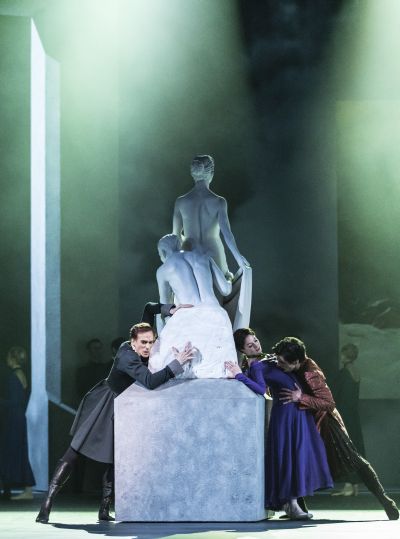 United Kingdom Joby Talbot, The Winter’s Tale: Dancers of The Royal Ballet, Orchestra of the Royal Opera House Orchestra / David Briskin (conductor), Broadcast to the Vue Cinema, Piccadilly, London, 28.4.2014. (JPr)
United Kingdom Joby Talbot, The Winter’s Tale: Dancers of The Royal Ballet, Orchestra of the Royal Opera House Orchestra / David Briskin (conductor), Broadcast to the Vue Cinema, Piccadilly, London, 28.4.2014. (JPr)

Cast included:
Hermione: Lauren Cuthbertson
Leontes: Edward Watson
Perdita: Sarah Lamb
Florizel: Steven McRae
Paulina: Zenaida Yanowsky
Polixenes: Federico Bonelli
Production
Choreography: Christopher Wheeldon
Music: Joby Talbot
Designs: Bob Crowley
Lighting design: Natasha Katz
Silk Effects designer: Basil Twist
Projection designer: Daniel Brodie
The biggest mystery of this live cinema broadcast was why Darcey Bussell was introducing it wearing what looked like a mixture of coloured sweets stuck to the collar of her dress and a couple of green ones as earrings? It was very distracting on the large screen at Piccadilly’s Vue Cinema.
More seriously, Shakespeare’s recent 450th anniversary was worthily celebrated by this new ballet based on The Winter’s Tale. Every story ballet could do with a mad king, a lost royal child eventually restored to her family, stormy sea voyages, a shipwreck, wedding festivities, and the famous stage direction, ‘Exit, pursued by a bear’. The story if no less absurd than any number of classic narrative ballets as the action moves after a Prologue and Act I at the court of Sicilia to bucolic shenanigans in Bohemia for Act II some sixteen years later and then back to Sicilia again for Act III.
Christopher Wheeldon does well with Act II and III but Act I overstays its welcome: it shouldn’t take so long to establish the closeness of Leontes of Sicilia and Polixenes of Bohemia as young princes and how a rift develops between them after Leontes’s marriage to Hermione because of his jealousy over their supposed infidelity. He believes the child she is carrying may be Polixenes’s and he has her arrested and brought to trial. Leontes is now quite mad and both his sickly son, Mamillius, and Hermione die. Paulina, the head of Hermione’s household, never loses faith in her and Antigonus, her husband, sets sail with the daughter she has given birth to. They reach the shores of Bohemia before he is eaten by that bear! The baby girl is discovered by a shepherd and his son along with some treasure and the emerald necklace Hermione was given by Leontes when they married.
In Act II we see an extravagantly large green Tree of Life hung with sparkly talismans. Perdita, the daughter of Leontes and Hermione is now all grownup; she dances with – and becomes engaged to – Florizel, Polixenes’s son, but here disguised as a shepherd boy. It is the time of the annual spring festival and villagers celebrate (accompanied by an onstage band) with much joyful dancing. At the height of the festivities Perdita is to be crowned May Queen and the shepherd who has raised her presents her with the emerald he found. Polixenes arrives in disguise (of course), forbids the marriage and condemns Perdita and her family to death. But they all flee with Polixenes following close behind. Back in Sicilia for Act III Perdita and Florizel plead with Leontes to allow their union; Polixenes arrives but Perdita, when manhandled, reveals the emerald. So the long-lost Princess of Sicilia has returned and the two kings can be reunited. There follows the wedding of Perdita and Florizel. But that is not the end of the story because Leontes is led by Paulina to see a new statue of Hermione and suddenly she comes to life. She has been in hiding for sixteen years (would you believe?), forgives Leontes and the family are back together once again.
As a ballet plot it veers from Mayerling (especially in showing the heavily-pregnant Hermione who dances very well for someone in her condition) and Hamlet in Act I, to Giselle and a hint of Le Corsaire in Act II, with a hint of Raymonda for the wedding near the end. Bob Crowley’s designs mix original images with some projections of the evocatively Romantic paintings of Caspar David Friedrich. Also there are some rather unnecessary statues to illustrate Leontes’s fevered imaginings about what his wife has been getting up to with Polixenes. Costumes were simple gowns for most of the women, fascist-like uniforms for the soldiers at the court of Sicilia, to a suitably ethnic look for the peasants. Interestingly, Perdita in Act II is dressed in purple to mirror Hermione’s look in Act I. The ships are shown on the raging seas through more video projection (by Daniel Brodie) and the waves themselves are recreated by some billowing silk. There seems to be an interesting juxtaposition of Poseidon and Shakespeare’s bear at the end of Act I – but I wasn’t certain quite sure what happened there.
To be truthful, there is a geographical fluidity to what we see and we are never shown a real country; this is also reflected in Joby Talbot’s new score (spiritedly conducted by David Briskin and well played by the orchestra) which seems like film music with the dance layered on it, rather than being inspired by it. It often had a percussive insistency that reflected Leontes’s torment well, but perhaps didn’t – with all its Greek colours – have all the lyricism necessary for the more pastoral moments with the two lovers, Perdita and Florizel. The composer himself who previously collaborated with Wheeldon on Alice’s Adventures in Wonderland distinguished the three acts as follows: ‘Act I has this musical language that is quite taut and troubled. In Act II we really want an absolute change … beautiful music, sets, costumes, just a lovely, lovely experience … Act III is very emotional, very lovely, we need to feel everything has led to this place … now the music is freer to express itself.’
For Leontes (Edward Watson), Hermione (Lauren Cuthbertson) and Paulina (Zenaida Yanowsky) Wheeldon’s choreography eschewed familiar classical movement for something more modern, stylistic, and with lots of gymnastic contortions: there is also a lot of semaphoring and clenched fists to denote jealously and distress. Nevertheless because these three are such accomplished actor-dancers I totally believed in the motivation behind their portrayals. Federico Bonelli as Polixenes was almost as good but he is given less to work with. In Act I when Hermione encourages both the men in her life to feel her baby move this is the pivotal moment which ignites Leontes’s unreasoning jealousy and we see it vividly reflected by Edward Watson’s writhing body.
The Bohemian characters are more traditional and Sarah Lamb’s ever-smiling Perdita and Steven McRae’s rather too-pleased-with-himself Prince of Bohemia have little to do but appear in love. In fact these two (of the six Royal Ballet Principals on stage) are the poorest actors and have only a few basic facial expressions at their disposal. Yet, they are light and airy dancers and Wheeldon gives them some joyful chorography. Charmingly a couple of times Perdita winds herself about Florizel’s shoulders and kisses him as she lowers herself down. Even more eye-catching and charismatic were Valentino Zucchetti as the shepherd’s son and Beatriz Stix-Brunell as his girlfriend and they dance very attractively together.
In Act III Paulina is revealed to be somewhat like The Sleeping Beauty’s Lilac Fairy, and conjures up a happy ending of sorts as she guides the king back to his faithful, and still living, wife, her mistress. There is a final heart-wrenching pas de deux as Leontes and Hermione rediscover their lost love for one another. There is genuine pathos here and it is a bit like the ending to Romeo and Juliet in the tomb – but here it is Leontes who dances with his resurrected wife. With the family reconciled, Crowley and Wheeldon end on a thought-provoking moment as we see the statue of their dead son Mamillius centre stage … Leontes’s sins have not entirely been absolved.
I think this ballet will have a future though it might need Wheeldon to tweak it a little; more importantly, it is a notable success for Kevin O’Hare, because it is his first major commission since becoming The Royal Ballet’s director in 2012. I hope I do not end on a too-indelicate comment but as a footnote to Ross MacGibbon’s close-up direction for the cinema screen can I suggest The Royal Ballet invests in some stronger antiperspirant as many of the costumes revealed some of the exertions of the dancers rather more than I have noticed in the past.
Jim Pritchard
